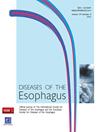594.患者特征和新辅助治疗对食管癌肿瘤微环境的影响
IF 2.3
3区 医学
Q3 GASTROENTEROLOGY & HEPATOLOGY
引用次数: 0
摘要
背景食管癌的预后仍然很差,因为即使采用目前标准的多模式治疗和肿瘤手术,许多患者对治疗仍无反应,或术后早期复发。在当前的精准医学时代,需要更好地了解肿瘤微环境(TME),以识别生物学特性不利的患者,同时也要说明宿主对治疗反应的生理病理。这项单中心转化研究旨在分析食管癌的生物分子特征与主要临床病理参数的关系,特别是与新辅助治疗反应的关系。方法 研究对象包括 2009 年 1 月 1 日至 2021 年 12 月 12 日期间接受治愈性食管癌手术的一系列患者。研究人员收集了临床病理数据,并由资深消化道病理学家对最初的活检和手术标本进行了重新评估。免疫浸润标志物 CD3、CD8、CD163、CD68、PDL1 和 FOXP3 以细胞计数/高倍视野的形式记录。CPS评分用于PD-L1的量化,而Mandard回归分级(TRG)用于评估对新辅助治疗(NAT)的病理反应。连续变量的比较采用 Mann-Whitney-U 检验和方差分析,分类变量的比较采用 Chi-2 检验。显著性阈值设定为 p<0.05。结果 共纳入 68 例患者(82.4% 为男性,平均年龄 62.4□9.4岁,79.4% 为腺癌)。吸烟者 TME 中的 M2 样细胞(CD163+,p=0.009)和总巨噬细胞(CD68+,p=0.001)含量较低,但 CD163/68 比率和 T 细胞含量与非吸烟者相似。腺癌组织学与鳞状细胞相比,显示出更高的 M2 样巨噬细胞(p=0.023)、平均 CPS 评分(p=0.038)和 T 细胞浸润(p=0.006)。NAT 增加了巨噬细胞和细胞毒性 T 细胞,减少了 TME 中的 Treg/FoxP3 细胞。与化疗相比,化疗与更高的T细胞TME浸润相关。对 NAT 反应良好者(TRG1-2)的 TME 初始特征与反应不佳者相似,但在最终组织学检查中,他们的巨噬细胞数量较低(P=0.003)。结论 在本研究中,主动吸烟与食管癌TME的M2样巨噬细胞浸润减弱有关,而腺癌组织学与M2样巨噬细胞浸润增强有关。新辅助治疗,尤其是化疗,会在TME中招募巨噬细胞和T细胞。虽然最终组织学检查发现巨噬细胞数量增加与反应不佳有关,但从最初活检中得出的生物标志物均与对 NAT 的反应无关。本研究为了解食管癌TME的组成提供了宝贵的信息。不过,还需要进一步的研究来评估TME元素(特别是巨噬细胞)的确切功能作用及其对临床结果的影响。本文章由计算机程序翻译,如有差异,请以英文原文为准。
594. THE IMPACT OF PATIENT CHARACTERISTICS AND NEOADJUVANT TREATMENT ON THE TUMOUR MICRO-ENVIRONMENT OF ESOPHAGEAL CANCER
Background Esophageal cancer remains associated with poor prognosis, as even with the current standards of multimodal treatment and oncologic surgery many patients show no response to treatment, or suffer early recurrence after surgery. In the current era of precision medicine, a better understanding of the tumor microenvironment (TME) is needed to identify patients with unfavourable biology, but also to illustrate the physiopathology of host reaction to treatment. The aim of this monocentric translational study was to analyse the biomolecular characteristics of esophageal cancer in relation to key clinicopathologic parameters, and in particular to the response to neoadjuvant treatment. Methods A series of patients operated for esophageal cancer with curative intent between 01.2009 and 12.2021 were included in this study. Clinicopathological data were collected, and initial biopsies and surgical specimens were reassessed by a senior GI pathologist. The immune infiltrate markers CD3, CD8, CD163, CD68, PDL1and FOXP3 were recorded as cell counts/high power field. The CPS score was used for PD-L1 quantification, whereas the Mandard regression grade (TRG) assessed pathologic response to neoadjuvant treatment (NAT). Continuous variables were compared with the Mann-Whitney-U and ANOVA tests, and categorical ones with the Chi-2 test. Significance threshold was set at p<0.05. Results Overall, 68 patients (82.4% males, mean age 62.4□9.4 years, 79.4% adenocarcinoma) were included. TME in smokers had lower M2-like (CD163+, p=0.009) and total macrophages (CD68+, p=0.001), but similar CD163/68 ratio and T-cells as non-smokers. Adenocarcinoma histology compared to squamous cell, showed higher M2-like macrophages (p=0.023), mean CPS score (p=0.038) and T-cell infiltration (p=0.006). NAT increased macrophages and cytotoxic T-cells, and decreased Treg/FoxP3 cells in the TME. Chemotherapy, compared to chemoradiation, was associated with higher T-cell TME infiltration. Good responders to NAT (TRG1-2) had similar initial TME characteristics as poor responders, but they displayed lower macrophage count upon final histology (p=0.003). Conclusions In the present series, active smoking was related to attenuated, whereas adenocarcinoma histology to enhanced M2-like macrophage infiltration of esophageal cancer TME. Neoadjuvant treatment, and especially chemotherapy, recruited macrophages and T-cells in the TME. None of the biomarkers derived from the initial biopsies were associated with response to NAT, although an increased macrophage count upon final histology was related to poor response. The present study provides valuable insight to the TME composition of esophageal cancer. However, further studies are needed to assess the exact functional role of TME elements, and specifically macrophages, and their impact on clinical outcomes.
求助全文
通过发布文献求助,成功后即可免费获取论文全文。
去求助
来源期刊

Diseases of the Esophagus
医学-胃肠肝病学
CiteScore
5.30
自引率
7.70%
发文量
568
审稿时长
6 months
期刊介绍:
Diseases of the Esophagus covers all aspects of the esophagus - etiology, investigation and diagnosis, and both medical and surgical treatment.
 求助内容:
求助内容: 应助结果提醒方式:
应助结果提醒方式:


